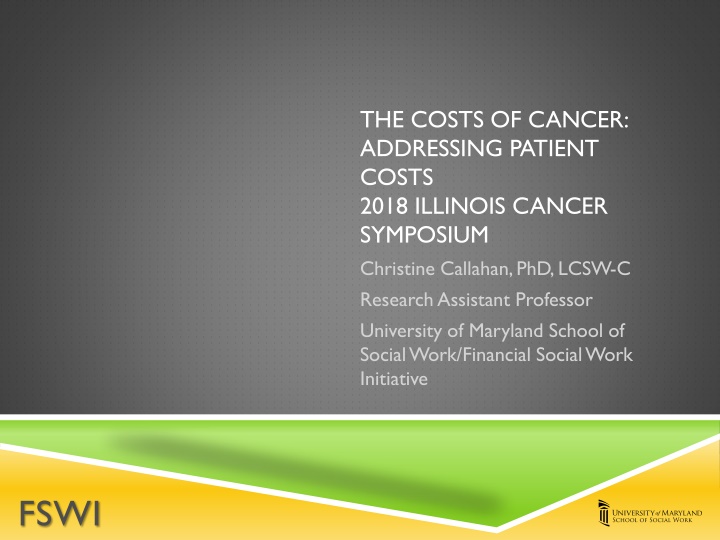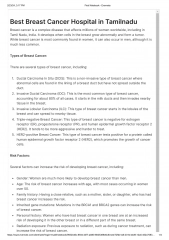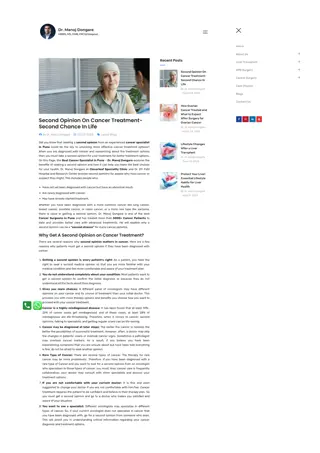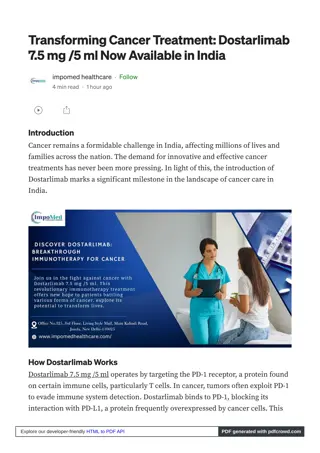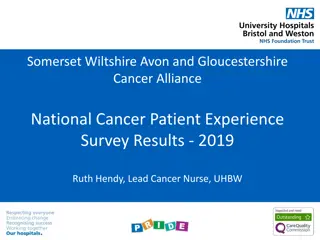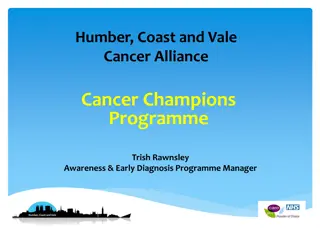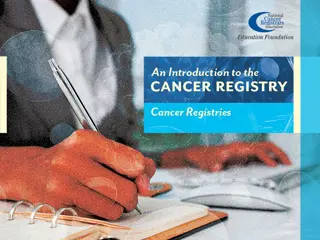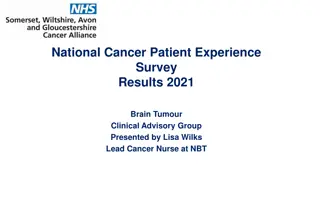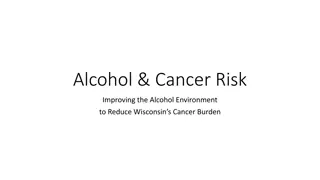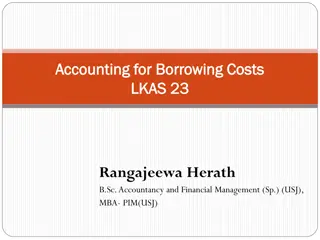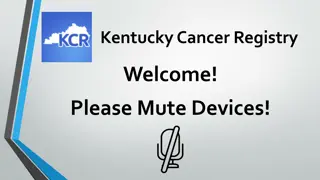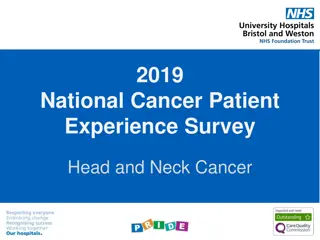Cancer Treatment Costs and Patient Financial Burden
This presentation delves into the costs of cancer treatment and the financial burden experienced by patients. Explore the impact of treatment expenses, insurance coverage, and other contributors to care. Gain insights from expert perspectives and key data sources.
Download Presentation

Please find below an Image/Link to download the presentation.
The content on the website is provided AS IS for your information and personal use only. It may not be sold, licensed, or shared on other websites without obtaining consent from the author.If you encounter any issues during the download, it is possible that the publisher has removed the file from their server.
You are allowed to download the files provided on this website for personal or commercial use, subject to the condition that they are used lawfully. All files are the property of their respective owners.
The content on the website is provided AS IS for your information and personal use only. It may not be sold, licensed, or shared on other websites without obtaining consent from the author.
E N D
Presentation Transcript
THE COSTS OF CANCER: ADDRESSING PATIENT COSTS 2018 ILLINOIS CANCER SYMPOSIUM Christine Callahan, PhD, LCSW-C Research Assistant Professor University of Maryland School of Social Work/Financial Social Work Initiative FSWI
SOME BACKGROUND Oncology social worker for 20+ years at the NIH Clinical Center Financial quality of life study for PhD dissertation Experience in professional and personal realms with cancer Research and education now on financial capability FSWI
LEARNING OBJECTIVES FOR THIS SESSION Examine costs of cancer treatment and how this affects people with cancer Understand specific details on the financial burden borne by patients with cancer Appreciate costs from patient point of view FSWI
INFORMATION SOURCES American Cancer Society Cancer Action Network (ACS CAN): The Costs of Cancer (2017) Report Scholarly and policy literature on financial burden faced by patients with cancer Clinical experiences FSWI
TOTAL U.S. EXPENDITURES FOR CANCER BY SOURCE OF PAYMENT-2014 44% private insurance 33% Medicare 15% Other 4% Medicaid 4% Patient Out-of-Pocket Costs = $3.9 billion TOTALING $87.8 BILLION Source: Medical Expenditure Panel Survey (MEPS) FSWI
TOTAL U.S. EXPENDITURES FOR CANCER BY TYPE OF SERVICE-2014 58% Hospital Outpatient or Office-Based Provider Visits 27% Hospital Inpatient Stay 12% Prescribed Medicines 2% Home Health 1% ER visits Source: MEPS FSWI
COSTS CONTRIBUTING TO CARE Nature of insurance coverage and type of plan Public or private? Associated costs, e.g., premium, deductible, co-pays, caps Supportive medicines and those costs In-network or out of network? Balance billing FSWI
OTHER IMPORTANT CONTRIBUTORS Treatment plan Geographical location Treatment setting Health disparities FSWI
INDIRECT COSTS SIGNIFICANT! Impact of work and income Benefits present or not? Hourly wage workers; spikes and dips in income Transportation, parking, and fuel Housing Child care Juggling multiple responsibilities, financial and otherwise Attending to other medical and psychosocial needs FSWI
RELATED FINANCIAL FACTORS Level of pre-existing debt Assets Wage-earner(s) in household and amount of income Low-income workers Objective and subjective levels of financial distress Nat l Cancer Institute, Financial Toxicity And Cancer Treatment FSWI
EMOTIONAL IMPACT Dealing with feelings around the cancer diagnosis and existential plight Feelings of being overwhelmed Feelings of hopelessness Prioritizing responsibilities and costs, but often neglecting one(s) for another At risk for depression, anxiety, and other conditions Presence of other simultaneous psychosocial stressors? FSWI
PATIENT PROFILE 1(BREAST CANCER) See hand-out FSWI
PATIENT PROFILE 2 (LUNG CANCER) See hand-out FSWI
PATIENT COSTS FOR BCA BY TYPE OF INSURANCE EMPLOYER Total: $5,819 INDIVIDUAL PLAN Total: $10,114 MEDICARE Total: $8,793 $3,475 co-pays & co-insurance $500 deductible $1,844 premiums $6,850 co-pays & co-insurance $3,264 Premiums $1,589 co-pays & co-insurance $4,978 Medigap premiums $766 Medicare Part D premiums $1,462 Medicare Part B Premiums FSWI
PATIENT COSTS FOR LUNG CA BY TYPE OF INSURANCE MEDICARE Total: $8,396 EMPLOYER Total: $5,654 INDIVIDUAL PLAN Total: $10,114 $3,310 co-pays & co-insurance $500 deductible $1,844 premiums $1,192 co-pays & co-insurance $4,978 Medigap premiums $766 Medicare Part D premiums $1,462 Medicare Part B premiums $6,850 co-pays & co-insurance $3,264 Premiums FSWI
KEY FINDINGS Type of insurance coverage is critical, and employer-based tends to be more generous Out-of-pocket limits help protect patients Costs vary widely Type of treatment costs vary as well FSWI
OTHER FINDINGS Cancer costs tend to be front-loaded and highest towards the beginning of care Medigap makes costs more consistent Timing also matters (yet often is beyond one s control) FSWI
COMPOUNDING FACTORS Out-of-network charges High Deductible Health Plans Non-covered treatments or changes in coverage Denials Lack of coverage FSWI
NAVIGATING THE MAZE Toll on physical and emotional energy Difficulty absorbing information Difficulty advocating for oneself, especially if social support is minimal Decision-making challenges FSWI
WHAT ELSE HELPS? Open, honest communication with the patient and family Team approach and utilizing expertise of all disciplines involved, e.g., medicine, pharmacy, nursing, social work, etc. Financial navigators and link with financial toxicity FSWI
FINANCIAL NAVIGATION IN ONCOLOGY (AND OTHER MEDICAL) SETTINGS Seeking out patients pro-actively (instead of working solely with uninsured patients or those asking for assistance) Reviewing and verifying all new patients insurance status Communicating with the patient about their insurance status, coverage as it relates to their tx plan, and expected cost of tx Using tools to evaluate financial toxicity Completing insurance optimization to identify the best insurance for each patient s needs, including applying for primary and secondary insurance Assisting patients in accessing financial resources MI Cancer Consortium, Financial Navigation for People Undergoing Cancer Treatment, 2/2018 FSWI
FINANCIAL NAVIGATION IN ONCOLOGY (AND OTHER MEDICAL) SETTINGS Completing paperwork for patients in applications for additional insurance, payment assistance, or drug assistance programs Connecting patients to other available social and financial supports Creating payment plans with patients Sharing payment plans with team, including clinic check-in staff who may be responsible for collecting co-pays Monitoring for potential new patients by noting insurance changes and working with accounts receivable, especially monitoring patients who miss payments MI Cancer Consortium, Financial Navigation for People Undergoing Cancer Treatment, 2/2018 FSWI
COmprehensive Score for Financial Toxicity (COST)- Items 1, 6, 7 and 11 should be reverse scored, as higher scores indicate higher distress. (de Sousa et al., 2017) 0 Not at all 1 A little bit 2 Somewhat 3 Quite a bit 4 Very much FSWI
INTERSECTION WITH THE FINANCIAL Recognizing that financial distress is prevalent, especially since the Great Recession Medical illness is the number-one reason for declaring bankruptcy Millions of Americans live without emergency savings or do not have the resources to manage for 3 months if faced with an emergency (Nat l Financial Capability Survey, 2012) Financial stability can suffer Living in or being at risk of living in poverty can be ever-present Becoming familiar with resources that promote financial stability (once crisis has passed) FSWI
RAINY DAY FUNDS From Nat l Financial Capability Survey, 2012
QUICK FACTS The American Community Survey (ACS) estimates the overall rate of people with disabilities in the US population in 2015 was 12.6% (keeps rising) More than one in five (21.2%) US citizens with disabilities of working- age in 2015 were living in poverty; for US citizens of working-age without disabilities, the national poverty rate was 13.8% An earnings disparity of over $10,000 in median earnings between those with and without disabilities has existed since at least 2008; the disparity has increased in magnitude since 2013. From 2016 Disability Statistics Annual Report
POVERTY AND PEOPLE WITH DISABILITIES More than one in five (21.2%) US citizens with disabilities of working-age in 2015 were living in poverty. For US citizens of working-age without disabilities, the national poverty rate was 13.8%. FINRA Report Respondents with work-related disability report: Greater difficulty making ends meet Participating in less financial planning Poorer management of financial products Lower financial literacy
QUESTIONS PATIENTS WITH CANCER MAY WANT TO ASK ABOUT TREATMENT COSTS I m worried about how much cancer tx is going to cost me. Can we talk about it? Will my health insurance pay for this tx? How much will I have to pay myself? I know this will be expensive. Where can I get an idea of the total cost of the tx we ve talked about? Adapted from ACS, 2017; cited in Carrera, Kantarjian, & Blinder, 2018 FSWI
MORE QUESTIONS FOR DISCUSSION WITH ONCOLOGIST AND TEAM If I can t afford this tx, are there others that might cost less but will work as well? Is there any way I can get help to pay for this treatment? Does my health insurance company need to preapprove or precertify any part of the tx before I start? Where will I get tx in the hospital, your office, a clinic, or at home? FSWI
POLICY IMPLICATIONS Health insurance: Comprehensive Adequate Affordable Available Easy to understand Expansion of Medicaid FSWI
CONTACT US! UMSSW Financial Social Work Initiative at the University of Maryland School of Social Work: www.ssw.umaryland.edu/fsw FSWI
REFERENCES Banegas, M.P. et al. (2018). For working-age cancer survivors, medical debt and bankruptcy create financial hardships. Health Affairs, 35(1), 54-61. de Sousa, J.B. et al. (2014). The development of a financial toxicity patient-reported outcome in cancer: the COST measure. Cancer 120, 3245-3253. Cancer Action Network/American Cancer Society. The Costs of Cancer: Addressing Patient Costs. Carrera, P. M. et al. (2018). The financial burden and distress of patients with cancer: understanding and stepping-up action on the financial toxicity of cancer treatment. CA Cancer Journal for Clinicians, 68, 153-165. Michigan Cancer Consortium. (2018). Financial navigation for people undergoing cancer treatment. Lansing, MI: Public Sector Consultants. National Cancer Institute. Financial toxicity and cancer treatment. Swanberg, J.E. et al. (2017). Managing cancer and employment: decisions and strategies used by breast cancer survivors employed in low-wage jobs. Journal of Psychosocial Oncology, 35(2), 180-201. FSWI
